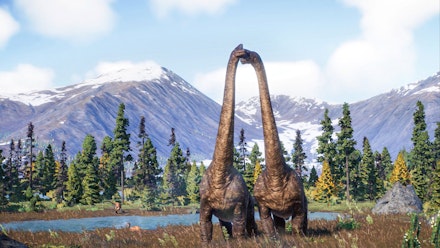Platforms: PS5, PS4, Xbox Series X|S, Xbox One, PC
With Colin Trevorrow's trilogy-capping Jurassic World: Dominion still seven months away, dino fans may be feeling a reptilian-shaped hole in their entertainment lives. Fear not: Frontier Development is here to cram five movies' worth of genetic accidents, plus an original campaign, into one thrilling… err, business sim?
No, wait, come back! Yes, Evolution 2 – like its 2018 predecessor – is primarily a management game, but it crams in enough else to do that even players who normally run screaming from a top-down grid might find something to enjoy. After all, you've probably never had to tranquilise a stampeding triceratops from a helicopter in Sim City, have you?
The main campaign is set in the aftermath of Jurassic World: Fallen Kingdom, with dinosaurs now roaming wild on the continental United States. Guided by Claire Dearing and Ian Malcolm (voiced by Bryce Dallas Howard and Jeff Goldblum, adding a dash of star power to the game) – plus a sound-not-very-alike Owen Grady in Chris Pratt's absence – you'll be rescuing dinosaurs and relocating them to new enclosures for their own protection.

It's these sections where the game comes alive more than many other sims. You'll be able to take direct control of ranger teams and their vehicles, zooming around the satisfyingly expansive maps to scout out wandering dinosaurs, mark their locations, and yes, sedate them for transport to safety. It's a mechanic that adds a lot more immersion than most city- or park-builder games, allowing you to become a part of the world, rather than remaining an omniscient god overlooking the world.
While you are in omniscient god mode though, Evolution 2 proves its credentials as a management sim. All the facilities that might be expected from building a dinosaur park are there to be experimented with, from variable fences to contain creatures of various sizes, to a host of maintenance and gene-splicing research facilities, right down to environmental tools that allow you to create appropriate habitats for each species. It's not just geo-mapping though – scientists need to be recruited to perform research, new facility types can be developed, and a multitude of other highly specified features can be invested in.

As stories go, the campaign is perfectly adequate but feels somewhat held back by being caught between the events of two blockbuster movies, unable to upturn any apple carts. Ultimately, it's a glorified tutorial for the wider game, and the pace at which it provides access to some of the more interesting facilities and research chains may frustrate.
Where Evolution 2 really comes alive though is Chaos Mode – think What If…?: Jurassic Park Edition. Diving into the events of all five movies from 1993's original, you'll be tasked with playing through key scenarios, with the potential to change the outcome of events. However, the clue is in the name – chaos typically reigns, as you'll be facing escaped dinosaurs, unpredictable weather and other random factors that test your resource and time management skills. It's perhaps to the other extreme than campaign, often threatening to overwhelm with the sheer amount of stuff to do when everything starts going inevitably wrong, but fans of the films will love the chance to tackle major on-screen events.
The sheer complexity of Evolution 2 throws up some frustrating roadblocks that can slow down an already methodically paced game.
Providing something of a balance between Campaign and Chaos is the sandbox mode, which operates more as a "pure" construction sim. Any genetic research, facilities, decorations, and – of course – dinosaurs unlocked in other modes are automatically available to use here, and the pace is essentially what you make it as you try to build the most successful facility.
Unfortunately, the sheer complexity of Evolution 2 throws up some frustrating roadblocks that can slow down an already methodically paced game. Even moving dinosaurs between enclosures – to separate prey from predators, for instance – seemingly always requires the beasts be sedated and then airlifted, every single time, for every individual creature. If there's a less arduous route, it's buried in a glut of menus – and the tiny text that accompanies them – beyond any easy or logical access. While time can be sped up to pass the time for retrieval, research, or construction tasks, a lot of the actual tasks in the game could do with some streamlining.
Perhaps "complexity" isn't the word though – a lot of the time, Evolution 2 just feels bogged down with busy work. Facilities run out of fuel and need to be manually topped up. Dinosaurs get ill, or sometimes injured if they fight, requiring manual intervention to send vets to them. Workers on your parks and preserves often need to be made to rest. These and dozens of other tasks mount up and end up feeling like distractions from the more interesting aspects of park building. That all these minor activities cost money can send you rapidly spiralling into virtual bankruptcy too, triggering what feel like impossible-to-win scenarios.
For those with an enduring passion for the cinematic Jurassics, Evolution 2 will still be a welcome distraction between films. Frontier has the tone of the world down almost flawlessly, and Chaos Mode in particular is a great addition. Sadly though, there are just a few too many frustrations scattered throughout the game's multitude of systems for it to really impress.
